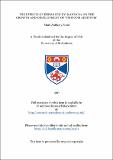Files in this item
The effects of enhanced UV-B and CO2 on the growth and development of 'Triticum aestivum'
Item metadata
| dc.contributor.advisor | Tobin, Alyson | |
| dc.contributor.author | Bond, Mark Anthony | |
| dc.coverage.spatial | 243 p. | en_US |
| dc.date.accessioned | 2018-05-28T09:41:07Z | |
| dc.date.available | 2018-05-28T09:41:07Z | |
| dc.date.issued | 1997 | |
| dc.identifier.uri | https://hdl.handle.net/10023/13561 | |
| dc.description.abstract | Seedlings of Triticum aestivum L. (cv Maris Huntsman) were propagated in a controlled environment chamber to 240hr (post-imbibition) under ambient, enhanced UV-B (200Wm-2), CO2 (550ppm and 700ppm) and combined UV-B/CO2 treatments. The grass leaf developmental model was used to determine changes in the cell-age gradient along the leaf length, under these treatments. By full leaf expansion, enriched CO2 had significantly increased leaf height, whilst this was decreased under enhanced UV-B, and decreased further under the combined UV-B/CO2 treatment. Analysis of the zones of cell division and cell elongation at the leaf base established that enriched CO2 increased mitotic activity and more so, cell elongation rates, whilst enhanced UV-B predominantly extended the duration of the cell division cycle. Under the combined UV-B/CO2 (550ppm) treatment it is proposed that cell division and cell elongation are greatly reduced at leaf emergence, but CO2-induced increases of cell division rates occur over time, prior to early cessation of leaf growth. The reduced leaf cell supply under enhanced UV-B+/-CO2 was accompanied by reductions in chlorophyll and protein synthesis at the leaf base, more so on a cell-age basis. Enhanced UV-B+/-CO2 did not alter the leaf Rubisco content. However, coleoptile Rubisco content was significantly reduced under enhanced UV-B, but this effect was ameliorated in combination with CO2. Large increases in UV-B-absorbing compounds accumulated along the leaf under enhanced UV-B+CO2 (550ppm), although this was attributed primarily to altered cell-age gradients rather than to UV-B induction per se. Analysis by Differential Display Reverse Transcription-PCR of the cell division zone has led to the isolation of 19 up-regulated and 11 down-regulated putative UV-B responsive transcripts. It is believed that the use of DDRT-PCR will further elucidate specific plant responses under these treatments. | en_US |
| dc.language.iso | en | en_US |
| dc.publisher | University of St Andrews | |
| dc.subject.lcc | SB191.W5B7 | |
| dc.subject.lcsh | Wheat | |
| dc.subject.lcsh | Wheat--Growth | |
| dc.title | The effects of enhanced UV-B and CO2 on the growth and development of 'Triticum aestivum' | en_US |
| dc.type | Thesis | en_US |
| dc.contributor.sponsor | Horticulture Research International | en_US |
| dc.type.qualificationlevel | Doctoral | en_US |
| dc.type.qualificationname | PhD Doctor of Philosophy | en_US |
| dc.publisher.institution | The University of St Andrews | en_US |
This item appears in the following Collection(s)
Items in the St Andrews Research Repository are protected by copyright, with all rights reserved, unless otherwise indicated.

